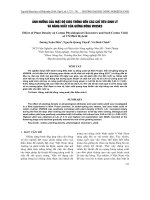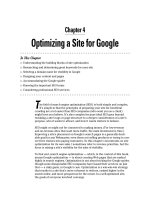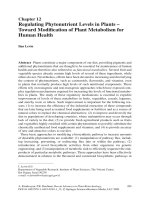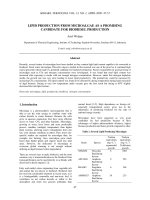Optimizing plant density for promising castor hybrid DCH 519
Bạn đang xem bản rút gọn của tài liệu. Xem và tải ngay bản đầy đủ của tài liệu tại đây (184.3 KB, 4 trang )
<span class='text_page_counter'>(1)</span><div class='page_container' data-page=1>
<i><b>Int.J.Curr.Microbiol.App.Sci </b></i><b>(2017)</b><i><b> 6</b></i><b>(11): 3694-3697 </b>
3694
<b>Original Research Article </b>
<b>Optimizing Plant Density for Promising Castor Hybrid DCH 519 </b>
<b>P. Kathirvelan* </b>
Tapioca and Castor Research Station, Tamil Nadu Agricultural University, P.G. Palayam,
Yethapur – 636 119, Salem, Tamil Nadu, India
<i>*Corresponding author </i>
<i><b> </b></i> <i><b> </b></i><b>A B S T R A C T </b>
<i><b> </b></i>
<b>Introduction </b>
Castor is one of the ancient and commercially
very important industrial and non-edible oil
crop in the world. It has the ability to grow
under low rainfall and fertility conditions, and
is most suitable for dryland farming. The oil
content of the seeds varies from 50-55% in
different hybrids and varieties. The
importance of oil arises from its richness of
ricinolic acid (85-95%) which has number of
uses in several industries. That is the reason
why castor has steady and staple market price
across the country and throughout the period.
Thus, castor is largely grown as rainfed crop
under wide range of soil and climatic
condition. One of the critical factors limiting
yield of castor hybrid is inadequate plant
density. The optimization of row spacing and
in-row plant density is a simple procedure
with a low cost but has a significant influence
on yield (Soratto <i>et al.,</i> 2012) and is essential
to maximize seed production. In fact, one of
the major reasons for low productivity in
hybrid castor in India is due to the
maintenance of inadequate plant population
and poor fertility management. A proper
utilization of inter row spacing for rising inter
crop with optimum plant density is necessary
to enhance the system productivity.
Optimizing planting population is an
inexpensive practice that can significantly
increase castor seed yield. However, the
optimum plant population varies influenced
<i>International Journal of Current Microbiology and Applied Sciences </i>
<i><b>ISSN: 2319-7706</b></i><b> Volume 6 Number 11 (2017) pp. 3694-3697 </b>
Journal homepage:
Field experiments were conducted at Tapioca and Castor Research Station, Experimental
farm during Rabi 2015 and <i>Kharif</i> 2016 season under irrigated and rainfed condition,
respectively to find out the optimum plant density for higher productivity and economics
of hybrid castor DCH 519. The experiment consisted of six treatments such as T1 120x120
cm, T2 150x120 cm, T3 150x150cm, T4 180x120 cm, T5 180x150 cm, T6180x180 cm. The
experiment was conducted in Randomized Block design with four replications. The results
of the experiment indicated that wider spacing of 180 x 180 significantly had the highest
yield attributing characters such as No. of effective spikes plant-1, primary spike length,
No. of capsules spike-1 which was observed to be on par with 180x150cm while
significantly higher plant height and seed yield were recorded under closer spacing of
120x120cm which was followed by 150x120cm spacing. Higher gross return of Rs.
51696/ha and net return of Rs.29596/ha with BCR of 2.33 was realized under closer
spacing of 120x120cm.
<b>K e y w o r d s </b>
Optimizing plant
density, Promising
castro hybrid.
<i><b>Accepted: </b></i>
26 September 2017
<i><b>Available Online:</b></i>
10 November 2017
</div>
<span class='text_page_counter'>(2)</span><div class='page_container' data-page=2>
<i><b>Int.J.Curr.Microbiol.App.Sci </b></i><b>(2017)</b><i><b> 6</b></i><b>(11): 3694-3697 </b>
3695
by the genotype, environmental conditions
and agricultural practices. Because
environmental conditions are not constant,
there is not an individual plant density that
can be broadly recommended for castor
(Severino <i>et al.,</i> 2006d). Castor exhibits
considerable plasticity to spacing variation
and available research data indicated that
castor hybrid performs better in terms of seed
yield and quality when sown under optimum
plant density. Adoption of wider spacing is
beneficial in reducing the severity of botrytis
disease, while in highly fertile soils with
adequate water facilities, wider spacing can
result in the lush growth of castor, leading to
plant lodging, hindering all agronomic
management practices including harvesting.
Thus, plant density plays a pivotal role in
influencing the seed yield. Castor exhibits
considerable plasticity to spacing variation
and available research data indicated that
castor hybrid performs better in terms of seed
yield and quality when sown under optimum
plant density. Considering all facts, the
experiment was conducted to standardize
optimum plant density for productivity
enhancement of DCH 519 both under rainfed
and irrigated ecosystem.
<b>Materials and Methods </b>
To find out the optimum plant density for
higher productivity and economics of hybrid
castor DCH 519, field experiments were
conducted at Tapioca and Castor Research
Station, Experimental farm during Rabi 2015
and <i>Kharif</i> 2016 season under irrigated and
rainfed condition, respectively with the
following treatments such as T1 120x120 cm,
T2 150x120 cm, T3 150x150cm, T4 180x120
cm, T5 180x150 cm, T6180x180 cm. The
experiment was conducted in Randomized
Block design with four replications. The soil
of the experimental field indicates red sandy
loam with non-calcareous type and available
nutrient status of the experimental site was
low in N & P (262 and 5.10 kg ha-1) and high
in K (355 kg ha-1). The germination
percentage of seed was more than 90 per cent
and the required plant population per unit area
as per the treatment was maintained with gap
filling done within 10 days after sowing.
Farm yard manure @ 12.5 t ha-1 was applied
commonly to all the treatments. A fertilizer
schedule of 60:30:30 kg N, P2O5 and K2O ha-1
were kept constant for all the treatments and
were applied along the planting rows as urea,
DAP and Muriate of Potash and covered with
soil. All other plant protection measures were
adopted as per the technical programme.
<b>Results and Discussion </b>
<b>Seasonal Variation (Rabi 2015 and </b><i><b>Kharif </b></i>
<b>2016)</b>
In general, irrespective of the treatment
effects, the crop performed better during <i>Rabi</i>
2015 season as compared to <i>Kharif</i> 2016
season. Higher seed yield obtained in <i>Rabi</i>
</div>
<span class='text_page_counter'>(3)</span><div class='page_container' data-page=3>
<i><b>Int.J.Curr.Microbiol.App.Sci </b></i><b>(2017)</b><i><b> 6</b></i><b>(11): 3694-3697 </b>
3696
<b>Table.1 </b>Growth and yield attributing characters of castor hybrid DCH 519 as influenced by plant density during 2015 and 2016 seasons
<b>Treatment </b> <b>Plant height (cm) at harvest </b> <b>Days to 50 % flowering </b> <b>No. of effective spikes/plant </b>
<b>Rabi 2015 </b> <b>Kharif 2016 </b> <b>Rabi 2015 </b> <b>Kharif 2016 </b> <b>Rabi 2015 </b> <b>Kharif 2016 </b>
T1 120x120 cm 121.4 86.2 65 68 9.5 6.9
T2 150x120 cm 117.7 84.0 64 67 9.9 7.2
T3 150x150 cm 114.6 74.7 65 67 10.9 8.8
T4 180x120 cm 115.5 82.2 65 67 10.2 8.5
T5 180x150 cm 112.2 73.8 64 68 11.4 10.1
T6 180x180 cm 111.3 71.3 65 68 12.8 10.6
SEd 7.10 5.07 0.75 0.75 1.46 1.37
CD (p=0.05) 14.92 10.66 1.59 1.58 3.07 2.88
<b>Table.2 </b>Yield attributing characters of castor hybrid DCH 519 as influenced by plant density during 2015 and 2016 seasons
<b>Treatment </b> <b>Length of primary spike (cm) </b> <b>No. of capsules/spike </b> <b>Test weight </b>
<b>Rabi 2015 </b> <b>Kharif 2016 </b> <b>Rabi 2015 </b> <b>Kharif 2016 </b> <b>Rabi 2015 </b> <b>Kharif 2016 </b>
T1 120x120 cm 60.1 56.7 84.5 65.6 26.5 24.8
T2 150x120 cm 62.6 57.4 88.2 73.4 26.4 25.0
T3 150x150 cm 68.5 60.2 92.7 81.2 26.6 25.1
T4 180x120 cm 66.7 58.1 90.5 79.8 26.5 24.9
T5 180x150 cm 72.3 61.0 95.4 88.7 26.5 25.1
T6 180x180 cm 75.2 62.5 98.3 89.5 26.9 25.2
SEd 4.67 4.10 5.96 5.51 0.85 0.85
CD (p=0.05) 9.81 8.62 12.52 11.56 1.78 1.79
<b>Table.3 </b>Seed yield and economics of castor hybrid DCH 519 as influenced by plant density during 2015 and 2016 seasons
<b>Treatment </b> <b>Seed yield (kg/ha) </b> <b>Cost of cultivation (Rs/ha) </b> <b>Net return (Rs/ha) </b> <b>BCR </b>
<b>Rabi 2015 </b> <b>Kharif 2016 </b> <b>Rabi 2015 </b> <b>Kharif 2016 </b> <b>Rabi 2015 </b> <b>Kharif 2016 </b> <b>Rabi 2015 </b> <b>Kharif 2016 </b>
T1 120x120 cm 2310 1426 26950 22100 56210 29236 3.08 2.32
T2 150x120 cm 2147 1355 26850 22000 50442 26780 2.88 2.22
T3 150x150 cm 2039 1382 26800 21950 46604 27802 2.74 2.27
T4 180x120 cm 1828 1237 26800 21950 39008 22582 2.46 2.03
T5 180x150 cm 1948 1257 26650 21800 43478 23452 2.63 2.08
T6 180x180 cm 1895 1271 26650 21800 41570 23956 2.56 2.10
SEd 113.4 73.1 - - - -
</div>
<span class='text_page_counter'>(4)</span><div class='page_container' data-page=4>
<i><b>Int.J.Curr.Microbiol.App.Sci </b></i><b>(2017)</b><i><b> 6</b></i><b>(11): 3694-3697 </b>
3697
Among different plant density evaluated, plant
height differed markedly at harvest. Closer
spacing of 120x120 was found superior over other
plant density during both seasons though it was at
par with 120x150 cm. Plant density did not have
any significant influence on days to fifty percent
flowering during both the seasons of study (Table
1).
<b>Effect of plant density on growth, yield </b>
<b>attributes and yield of castor hybrid DCH 519 </b>
Plant population had a significant influence on the
growth and yield attributing characters of castor
as evidenced from the results of the experiment.
During both the season, wider spacing of 180 x
180 significantly had the highest yield attributing
characters such as No. of effective spikes plant-1,
primary spike length, No. of capsules spike-1
which was observed to be on par with
180x150cm. As the feeding zone of castor hybrid
per plant under wider spacing is more when
compared to closer spacing, the plants grew
laterally and resulted in higher number of
productive branches plant-1 (Table 2). Similar
findings are in accordance with Kathirvelan <i>et al.,</i>
(2006). The better yield attributing characters in
wider row spacing (180 x 180 cm) was mainly
due to sufficient space between rows which
encouraged to produce more vigorous plants and
also lesser interplant competition for space, light,
nutrient and moisture and resulted in more source
to sink movement and partitioning efficiency. The
reduction in other yield attributing characters <i>viz</i>.,
seed yield and haulm yield in wider row spacing
of 180x180 cm was associated with lower plant
population load per unit area.
Significantly higher plant height was recorded
under closer spacing of 120x120cm which was
followed by 150x120cm spacing. No significant
difference was observed among the plant densities
with respect to days to fifty percent flowering
because this parameter is mainly governed by the
genetic makeup of the plants. Though the yield
attributes like No. of effective spikes plant-1,
primary spike length and No. of capsules spike-1
were increased significantly with lower plant
population of 3086 plants ha-1 (180 x 180 cm),
castor seed yield was significantly higher (1436
kg ha-1) with a higher population level of 6944
plant ha-1 (120x120 cm) which was observed to be
on par with 150x120 cm (1355kg ha-1). This was
mainly due to increased population load per unit
area. With respect to economics, higher gross
return of Rs. 51696/ha and net return of
Rs.29596/ha with BCR of 2.33 was realized under
closer spacing of 120x120cm (Table 3). From this
study, it could be concluded that closer spacing of
120 x120 cm had recorded significantly higher
yield attributing characters and seed yield with
higher monitory returns.
<b>References </b>
Guilherme Eugenio Machado Lopes, Henrique
Duarte Vieira and Fabio Luiz Partelli. 2013.
Response of Castor Bean Plants to
Different Row Spacings and Planting
Seasons. American Journal of Plant
Sciences, 2013, 4, 10-15.
Kathirvelan, P., and P. Kalaiselvan.2006. Growth
Characters, Physiological Parameters, Yield
Attributes and Yield as Influenced by the
Confectionery Groundnut Varieties and
Plant Population. Research Journal of
Agriculture and Biological Sciences, 2(6):
287-291.
Severino, L.S., C.R.A. Moraes, T.M.S. Gondim,
G.D. Cardoso, and N.E.M. Beltrao. 2006d.
Yield of castor planted at different row
space. Revista Ciencia Agronomica 37:50–
54.
Soratto, R. P, Souza-Schlick, G. D, Fernandes, A.
M, Zanotto, M. D, Crusciol, C. A. C.
Narrow row spacing and high plant
population to short height castor genotypes
in two cropping seasons. Industrial Crops
and Products, V. 35, N. 1, p. 244-249.
<b>How to cite this article: </b>
Kathirvelan, P. 2017. Optimizing Plant Density for Promising Castor Hybrid DCH 519.
</div>
<!--links-->
DETERMINATION OF THE DIGESTIBILITY OF SOME PLANT INGREDIENTS FOR GRASS CARP (Ctenopharyngodon idella)
- 7
- 492
- 0








